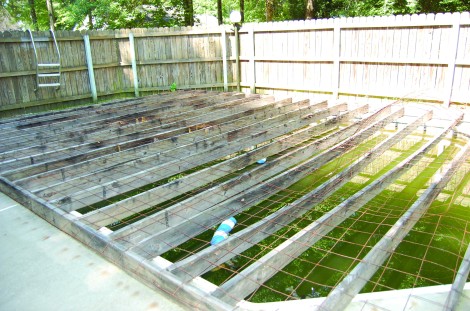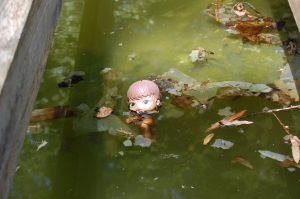This post is an updated excerpt from several years ago from a post about my former home’s pool. I moved to Georgia for a brief period, bought a “handy-girl” special that was a HUD foreclosed property, and after pouring my heart, soul, and bank account into it, I moved back to Florida. There are a few highlights to this story that are still relevant to today’s home buyer. If you purchase a home with a pool in need, make sure you have a great pool company to lean on to help you get through the renovation, especially if you are like I was – a first time pool owner.
Things I didn’t know about pool ownership could fill the pool. Unfortunately, it was already full of green, nasty water. It was frightening! I didn’t know, or even understand, that an in-ground pool could have a liner. I thought only above ground pools had liners. The bank repossessed the home and HUD immediately sent over a team to empty the pool and cover it with boards, fencing, and heavy-duty plastic sheeting in order to keep the pool as safe as possible before it was even released to the market. That’s where things got confusing. Since the pool was covered, there was no way to see inside it to determine its condition. There were so many other things that needed immediate attention, so I put the pool on the bottom of the to-do list.

This is the “cover” that HUD installed upon foreclosure of the home. While it was a safe remedy, there was no way to get a good look at the pool to know what to do first. The pool was quickly filled with rain water, which turned green and murky before we even knew!
First, a pool with a liner should never be emptied. The liner will begin to breakdown and cause serious problems. It will also be very difficult to keep the liner intact when the filling process begins again. So, it’s almost a perfect bet that a new liner will have to be installed. This liner was a goner before we even purchased the home.
Second, when the liner disintegrates, the actual pool interior will also begin to disintegrate. If the pool construction is gunite or fiberglass, the product could experience cracking or other serious problems. If the interior is fiberglass, exposure to the sun could cause that product to breakdown. That goes for the vinyl liner too.
Third, the longer the period of time between when the pool was in good condition and bad condition could determine the amount of money required to bring it back to good health. We had no way of knowing how bad this pool’s condition really was.

The once blue liner was destroyed by the elements. This is not looking good!
There are other considerations such as the pump and assorted equipment, as well as the filter system and decking if any.
My pool had a vinyl liner. The previous home owner apparently never attempted a good pool cleaning! After too many years of neglect, I had to purchase a new liner. They are not cheap. Try somewhere in the range of $5000 and that’s for a small pool. After considering the amount of money I would be dumping into this hole in my back yard, I decided to “do it right,” and get the best pool liner, switch over to a saltwater system, and get a very heavy-duty cover that would not only protect my pool during winter months, but also protect children and animals. You’ve probably seen the commercials for the pool cover that an elephant can stand on and be supported? Or maybe the one with the car parked on the cover and being supported? That’s the kind of cover I got. It was under $2000, but worth every penny when considering the nightmares I was having about the nasty, thick green water that would make recovery nearly impossible. The cover is extremely thick canvas-type material. It has springs attached which are connected to a bolting system on the concrete edges of the pool. The bolts are inset into the concrete, so there’s no problem with them interfering with your normal pool activities. I highly recommend this type of pool cover, especially if your pool will be closed for the winter. It keeps it fairly clean of all debris until you are ready to open the pool for swimming season, in addition to providing top security.

This cover is the best money spent! It will give you peace of mind knowing that nothing can get in that pool! It’s a beast to put on, but it will also save your pool through the winter season if you don’t have a screened area. I fell backwards onto it while blowing leaves. It supported me and I was able to recover quickly – and I was dry!
A few words about a saltwater system: do yourself a favor! If you are replacing the equipment such as the filter system and pump, etc. go to the extra expense and get a salt system. In the long run, you will save money as there are very few chemicals to buy other than salt. The salt turns into chlorine, in case you are wondering how the pool stays clean. Blonde hair will never turn green and bathing suits will never lose their color with a salt system. It’s so refreshing to get out of a saltwater pool and not have your flesh burning off because of the chlorine. Enjoy the photos below of my pool renovation.

During renovation. The HUD cover has been removed. The water looks like a Georgia swamp. The pump miraculously still worked! The fence was a mess!

This is truly what was in the pool when we took the cover off! Creepy!

The finished product! I stained the fence, pressured washed the concrete, and painted the trim around the sides of the pool. Total spent? Just under $8000. Lesson learned? Take good care of your vinyl liner! We loved having the pool, and my favorite thing to do was spend time cleaning it. I know, that’s just weird. It’s very relaxing to sweep a pool and watch the robo-vacuum at work!


